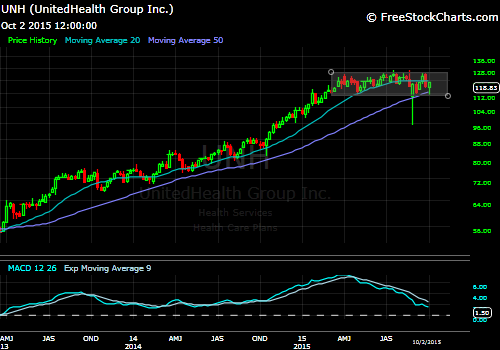So how do we navigate when we don't know which direction the next 10-20% move will go? First of all we follow the price action. What are the trends telling us? Are the Longer, Intermediate and Short-term trends still moving higher? Second we look for hints in the overall environment to guide our process.
SP500 Monthly (Long-term)
Looking back at the last 20 years it appears the market still has its long-term upward trajectory. The long-term, secular trend remains intact.
SP500 Weekly (Intermediate-term)
The weekly view shows the first declining 20 WMA since 2011. Price has not recovered from its initial decline in August and is guilty until proven innocent. The intermediate trend is bearish.
SP500 Daily (Short-term)
SP500 Monthly (Long-term)
Looking back at the last 20 years it appears the market still has its long-term upward trajectory. The long-term, secular trend remains intact.
SP500 Weekly (Intermediate-term)
The weekly view shows the first declining 20 WMA since 2011. Price has not recovered from its initial decline in August and is guilty until proven innocent. The intermediate trend is bearish.
SP500 Daily (Short-term)
The daily timeframe shows similar trend damage as the weekly, but also that there is a new trading range forming between 2000-1870. Price could certainly move higher over the short-term and retest the upper range and declining 50 DMA.
When you consider these three timeframes it appears to me the market remains in a short-term to intermediate-term correction within the context of a larger bull market phase. Sticking with this assumption I believe we are in a very typical 4th-wave correction within a larger 5-wave uptrend.
When you consider these three timeframes it appears to me the market remains in a short-term to intermediate-term correction within the context of a larger bull market phase. Sticking with this assumption I believe we are in a very typical 4th-wave correction within a larger 5-wave uptrend.
5 waves bull phase (currently in wave 4)
This is certainly an interpretive look at the price action, as is the problem with Elliot Wave Theory, but it does provide a basic framework to draw from. The 2011 correction formed wave 2 in our sequence. I wouldn't be outrageous to consider a similar movement to around the 50 MMA as the projected target for this wave 4 correction. Currently the 50 MMA sits near 1,700, a test of that area would still be considered normal corrective behavior within the larger bull market.
If we stick to more traditional technical analysis we can look to the concept of polarity. Polarity suggests that when a level has acted as strong resistance, once broken it should then become the new support.
Secular base breakout at 1600
This is certainly an interpretive look at the price action, as is the problem with Elliot Wave Theory, but it does provide a basic framework to draw from. The 2011 correction formed wave 2 in our sequence. I wouldn't be outrageous to consider a similar movement to around the 50 MMA as the projected target for this wave 4 correction. Currently the 50 MMA sits near 1,700, a test of that area would still be considered normal corrective behavior within the larger bull market.
If we stick to more traditional technical analysis we can look to the concept of polarity. Polarity suggests that when a level has acted as strong resistance, once broken it should then become the new support.
Secular base breakout at 1600
There was clearly a resistance level at the all-time highs near 1,500 going back almost 15-years. In early 2013 the market broke through that resistance level and we have been riding that breakout up until the last couple months. Classic technical analysis suggests an eventual retest of this breakout. This doesn't mean it has to happen now, but it would fit the current setup within our theory.
While the media wants to categorize everything into a neat fitting box, regardless of whether the current correction becomes a "bear market" or not isn't really important. What is important is understanding the context of the moves within the larger timeframe. Saying that if the market declines 20% its a "bear market" doesn't tell us much about the actual trends in place. After a 300% rally, a 20-30% correction isn't that unreasonable and it doesn't change the fact that the market remains in breakout mode.
This is where the concept of cyclical vs secular movements come into play. As we have seen before the market can have shorter-term, cyclical bear markets within larger bull markets. Its certainly possible based the intermediate trend declining that this becomes a "bear market" in the eyes of the media and gives investors a good scare before it ends. But its also possible once the correction plays itself out that the long-term bull market continues.
This is where the concept of cyclical vs secular movements come into play. As we have seen before the market can have shorter-term, cyclical bear markets within larger bull markets. Its certainly possible based the intermediate trend declining that this becomes a "bear market" in the eyes of the media and gives investors a good scare before it ends. But its also possible once the correction plays itself out that the long-term bull market continues.
What all this amounts to is KNOW YOUR TIMEFRAME. If you are a trader then you should be able to find many opportunities created by the volatility of the shorter-term trading range. If you are an investor there is cause for some caution over the intermediate term, but until the breakout near 1,500 fails its likely best to continue to be patient.
--Here are a list of stocks that are holding up remarkably well and are supported by large bases. Its important to monitor the strongest stocks during a correction. Once the correction ends, these names tend to lead to the way back up. These are a few of the Lg-Cap stocks I'm watching for our portfolio.










No comments:
Post a Comment